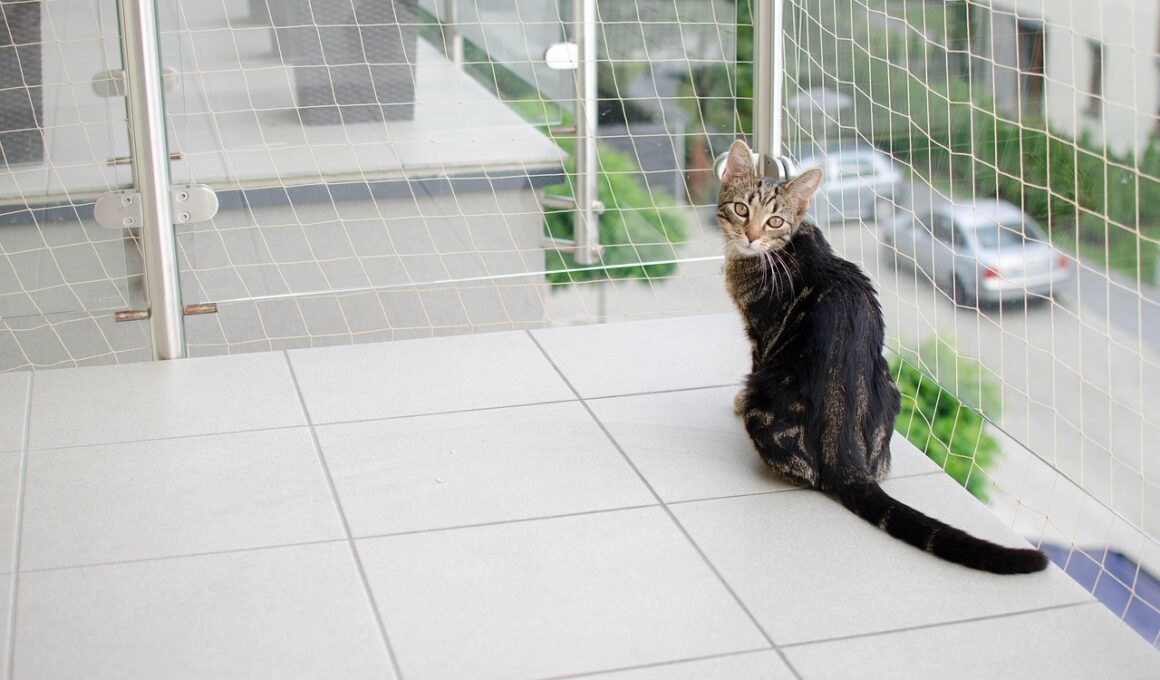How to Create an Allergy-Safe Environment for Your Cat
Creating a safe home for your cat involves recognizing and addressing allergies and sensitivities. Cats can suffer from various allergies to environmental factors, food, and even products in your home. These issues can lead to discomfort, health problems, and even chronic conditions if left untreated. The first step is to identify specific allergens. This process might involve observing the cat’s behavior and symptoms or consulting with a veterinarian. Common signs include itching, sneezing, vomiting, or digestive issues. Maintaining a log of when allergies occur can help pinpoint the triggers. Another vital aspect is to minimize exposure to known allergens. Regular cleaning of your home, such as vacuuming carpets and washing bedding, can reduce dust, pollen, and dander. Using air purifiers and hypoallergenic materials can further assist in creating an allergy-safe environment. Remember to avoid using harsh chemicals for cleaning that may irritate your cat. Instead, consider natural alternatives that offer a safer option while effectively maintaining cleanliness. Finally, keep your cat’s stress levels low, promoting overall well-being and resilience against allergies.
Identifying food allergies and sensitivities is crucial to your cat’s health. Food allergies can lead to similar symptoms as environmental allergies but typically manifest as digestive issues or skin irritations. Many cats can develop sensitivities to certain proteins or additives in their food. To determine if your cat has a food allergy, consult your veterinarian about testing or consider an elimination diet. This process involves feeding your cat a simplified diet for a specific period and then gradually reintroducing potential allergens. By monitoring your cat’s reactions, it may reveal problematic ingredients. It is essential to choose high-quality pet food with limited ingredients and no fillers, which often exacerbate problems. Reading labels thoroughly will ensure that you avoid common allergens such as beef, dairy, or grains. Additionally, consider consulting with a veterinary nutritionist to tailor your cat’s diet according to their specific needs and sensitivities. For cats with known allergies, a diet tailored to their sensitivities is crucial to their health and comfort. Regular veterinary check-ups ensure that any changes in allergies or symptoms are managed timely.
Maintaining a Allergen-Free Home
To maintain an allergen-free home for your cat, essential steps can help eliminate triggers and promote overall wellness. Start by evaluating your living space and removing potential sources of allergens. If your cat is allergic to dust mites or pollen, frequent vacuuming and dusting can drastically lower exposure. Keep windows closed during peak pollen seasons, and clean your home regularly to prevent dust accumulation. Pay special attention to areas where your cat frequents, such as their bedding, litter box, and favorite spots. Additionally, consider using washable bedding made from hypoallergenic materials. These can help minimize allergens and can easily be cleaned. It is crucial to avoid using scented candles or aerosol sprays that may irritate your cat’s respiratory system. Instead, opt for natural air purifiers or essential oil diffusers that are safe for pets. Implementing these practices not only benefits your cat but improves the overall air quality in your home, making it a comfortable and safe environment. Be proactive about identifying and addressing allergens, ensuring your cat thrives and feels cozy at home.
Designating specific areas in your home for your cat can significantly decrease exposure to allergens. Consider creating a “cat zone,” which is a designated space where your feline friend can relax without contact with potential allergens. This area should be equipped with their food, water, toys, and resting spots to encourage them to stay in the safe zone. It is important to keep this space free from allergens and thoroughly cleaned. Using mats or rugs in this area can help contain allergens; ensure these are washable and made from hypoallergenic materials. Having an easily accessible area reduces the likelihood of your cat wandering elsewhere in the home to potentially harmful locations. Additionally, ensure that other pets in the home are healthy and free from parasites or allergies that could affect the cat. By designating a specific zone, you can funnel your cat into a safe area while limiting the risk of exposure to potential triggers. Creating these spaces not only helps in managing allergies but also provides comfort and security, which is essential for your cat’s overall well-being.
Choosing Safe Products
Selecting the right products in your home can have a huge impact on your cat’s allergy management. When choosing cleaning products, opt for biodegradable, non-toxic, and hypoallergenic options. Harsh chemicals commonly found in household cleaners can irritate your cat’s sensitive skin and respiratory system. Always check for certifications or labels that indicate products are pet-safe. When it comes to grooming products, selecting shampoos and conditioners designed specifically for sensitive skin is crucial. Ingredients should be safe, and clear, avoiding harsh parabens or fragrances that could trigger allergies. Additionally, consider using natural flea and tick prevention methods that lessen the likelihood of allergic reactions. Speak to your veterinarian regarding the best treatments suitable for your cat’s health. Always remember that any changes to your regular cleaning or grooming routine should be introduced gradually to monitor your cat’s reactions. Keep track of how your cat responds to these changes, and make further adjustments as necessary. By prioritizing safe products, you are ensuring a healthier environment for your beloved pet.
It’s essential to regularly monitor your cat’s health and behavior to manage allergies effectively. Maintaining a close relationship with your veterinarian will help in detecting any changes early on. Frequent check-ups can assist in identifying new sensitivities, especially in older cats as their immune systems may change over time. Pay attention to signs of distress or new allergy symptoms; conduct regular assessments of your cat’s physical condition and behavior, observing any patterns that may emerge. If your cat exhibits unusual scratching, licking, or changes in appetite, report these to your vet immediately. Keeping a detailed journal of your cat’s health can be beneficial when discussing issues with your vet. This should include food intake, outdoor access, and any changes in behavior. The more informed you are, the better you can advocate for your cat’s health. Be proactive in staying alerted to potential health issues while catering to their comfort and safety. Regular monitoring allows you to adjust your strategies effectively to ensure that your home remains an allergy-safe environment.
Conclusion
Creating an allergy-safe environment for your cat entails a multi-faceted approach that should consider both the home environment and the pet’s health. By recognizing allergies, maintaining a clean space, choosing safe products, and keeping in close contact with a veterinarian, you can significantly improve your cat’s quality of life. Proactive measures, such as eliminating allergens, will lead to long-term benefits for your cat’s health and happiness. Additionally, ongoing education about your pet’s specific needs fosters a better understanding of their well-being. Addressing allergies is not just about responding to existing issues but also preventing potential problems in the future. Ensuring your cat’s comfort strengthens the bond shared and promotes a happier life together. It is an ongoing process, requiring commitment and vigilance, but the rewards are immensely worth the effort. Ultimately, maintaining a safe and nurturing environment for your cat is crucial, allowing them to thrive without the discomfort of allergies while enjoying their life in a loving home.



